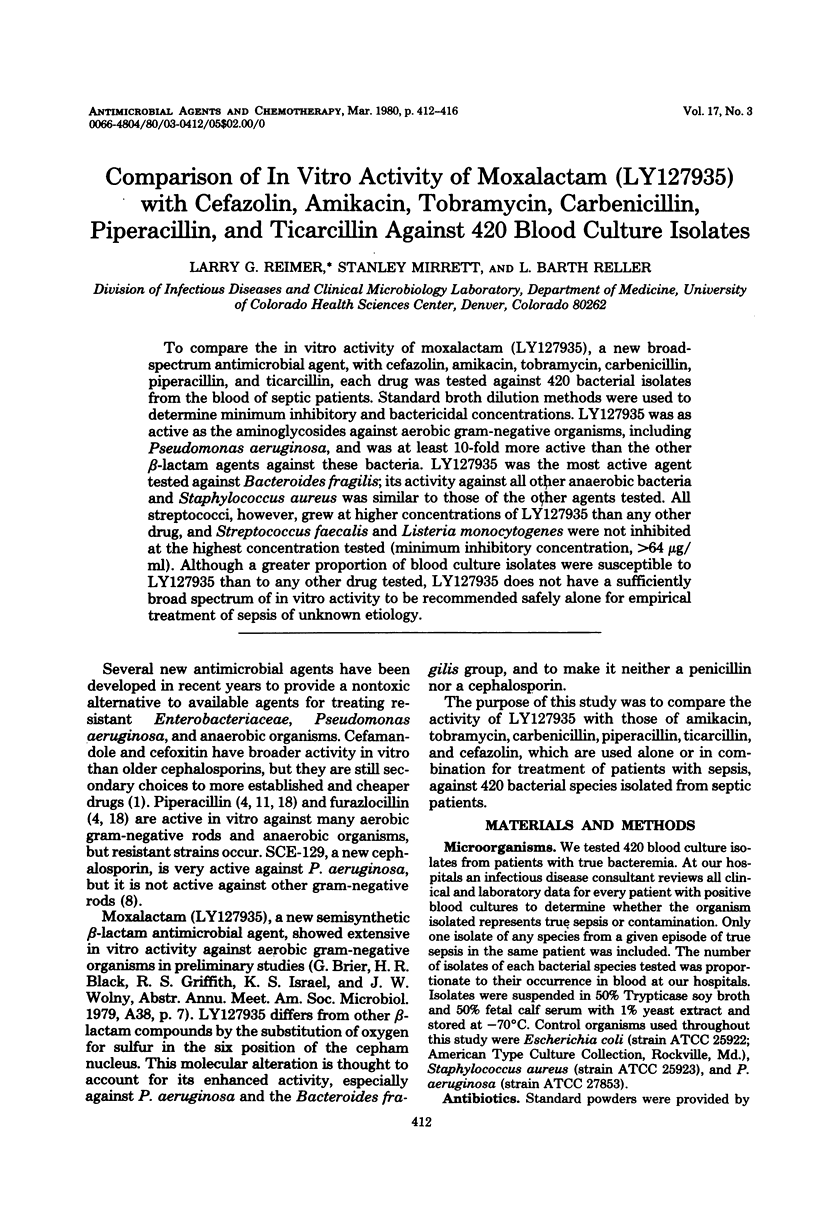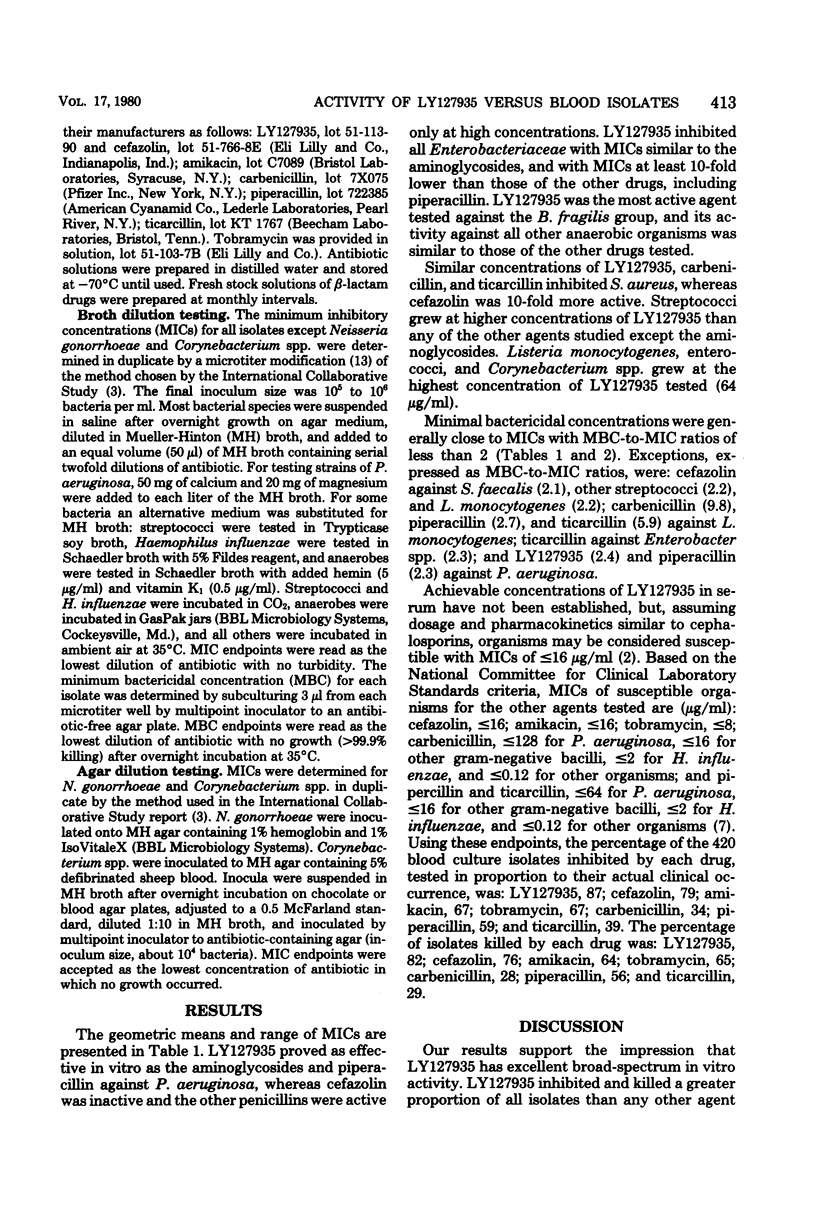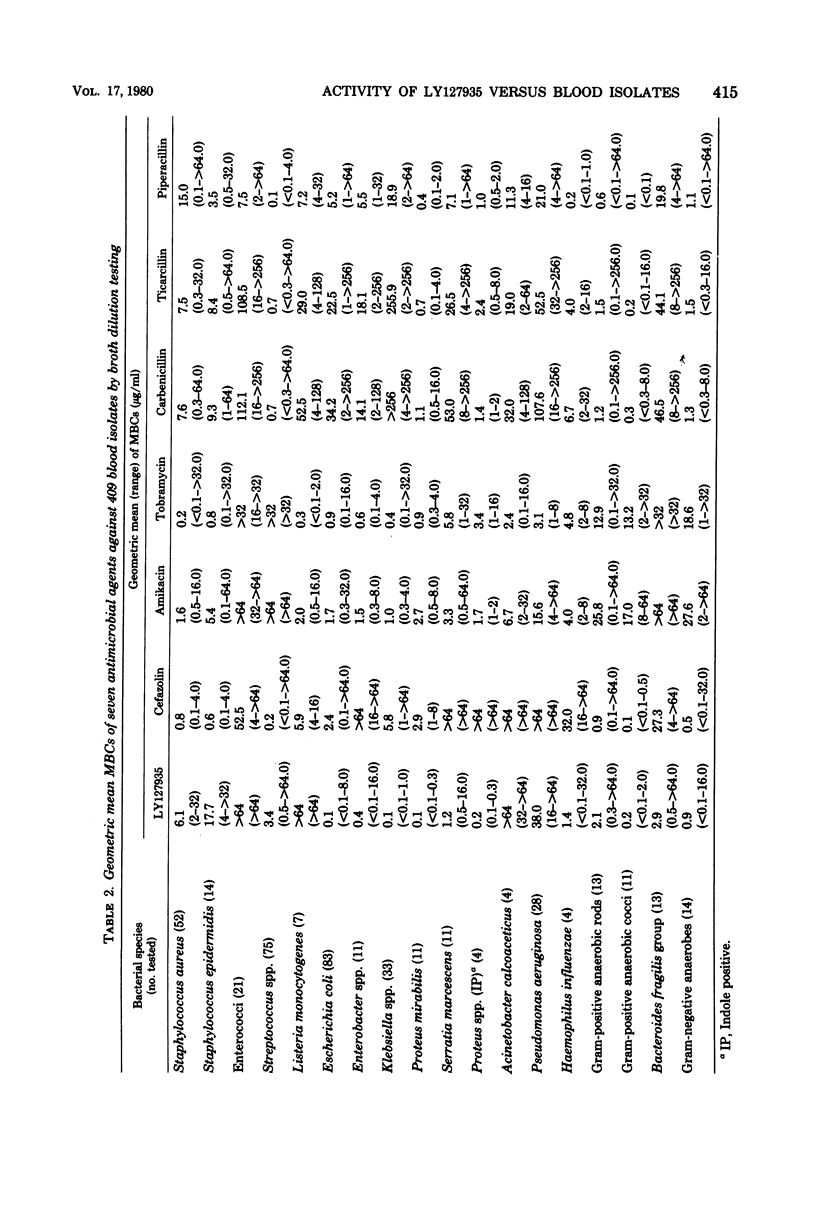Abstract
To compare the in vitro activity of moxalactam (LY127935), a new broad-spectrum antimicrobial agent, with cefazolin, amikacin, tobramycin, carbenicillin, piperacillin, and ticarcillin, each drug was tested against 420 bacterial isolates from the blood of septic patients. Standard broth dilution methods were used to determine minimum inhibitory and bactericidal concentrations. LY127935 was as active as the aminoglycosides against aerobic gram-negative organisms, including Pseudomonas aeruginosa, and was at least 10-fold more active than the other beta-lactam agents against these bacteria. LY127935 was the most active agent tested against Bacteroides fragilis; its activity against all other anaerobic bacteria and Staphylococcus aureus was similar to those of the other agents tested. All streptococci, however, grew at higher concentrations of LY127935 than any other drug, and Streptococcus faecalis and Listeria monocytogenes were not inhibited at the highest concentration tested (minimum inhibitory concentration, > 64 microgram/ml). Although a greater proportion of blood culture isolates were susceptible to LY127935 than to any other drug tested, LY127935 does not have a sufficiently broad spectrum of in vitro activity to be recommended safely alone for empirical treatment of sepsis of unknown etiology.
Full text
PDF




Selected References
These references are in PubMed. This may not be the complete list of references from this article.
- Barry A. L., Schoenknecht F. D., Shadomy S., Sherris J. C., Thornsberry C., Washington J. A., Kammer R. B. Interpretive criteria for cefamandole and cephalothin disk diffusion susceptibility tests. Antimicrob Agents Chemother. 1979 Jan;15(1):140–141. doi: 10.1128/aac.15.1.140. [DOI] [PMC free article] [PubMed] [Google Scholar]
- Gootz T. D., Sanders C. C., Sanders W. E., Jr In vitro activity of furazlocillin (Bay k 4999) compared with those of mezlocillin, piperacillin, and standard beta-lactam antibiotics. Antimicrob Agents Chemother. 1979 Jun;15(6):783–791. doi: 10.1128/aac.15.6.783. [DOI] [PMC free article] [PubMed] [Google Scholar]
- McGowan J. E., Jr, Barnes M. W., Finland M. Bacteremia at Boston City Hospital: Occurrence and mortality during 12 selected years (1935-1972), with special reference to hospital-acquired cases. J Infect Dis. 1975 Sep;132(3):316–335. doi: 10.1093/infdis/132.3.316. [DOI] [PubMed] [Google Scholar]
- McGowan J. E., Jr, Terry P. M. Susceptibility of gram-negative aerobic bacilli resistant to carbenicillin in a general hospital to piperacillin and ticarcillin. Antimicrob Agents Chemother. 1979 Jan;15(1):137–139. doi: 10.1128/aac.15.1.137. [DOI] [PMC free article] [PubMed] [Google Scholar]
- Neu H. C., Fu K. P. In vitro antibacterial activity and beta-lactamase stability of SCE-129, a new cephalosporin. Antimicrob Agents Chemother. 1979 May;15(5):646–650. doi: 10.1128/aac.15.5.646. [DOI] [PMC free article] [PubMed] [Google Scholar]
- Roy I., Bach V., Thadepalli H. In vitro activity of ticarcillin against anaerobic bacteria compared with that of carbenicillin and penicillin. Antimicrob Agents Chemother. 1977 Feb;11(2):258–261. doi: 10.1128/aac.11.2.258. [DOI] [PMC free article] [PubMed] [Google Scholar]
- Scheckler W. E. Septicemia in a Community Hospital 1970 through 1973. JAMA. 1977 May 2;237(18):1938–1941. [PubMed] [Google Scholar]
- Shah P. P., Briedis D. J., Robson H. G., Conterato J. P. In vitro activity of piperacillin compared with that of carbenicillin, ticarcillin, ampicillin, cephalothin, and cefamandole against Pseudomonas aeruginosa and Enterobacteriaceae. Antimicrob Agents Chemother. 1979 Mar;15(3):346–350. doi: 10.1128/aac.15.3.346. [DOI] [PMC free article] [PubMed] [Google Scholar]
- Singer C., Kaplan M. H., Armstrong D. Bacteremia and fungemia complicating neoplastic disease. A study of 364 cases. Am J Med. 1977 May;62(5):731–742. doi: 10.1016/0002-9343(77)90876-2. [DOI] [PubMed] [Google Scholar]
- Stratton C. W., Reller L. B. Serum dilution test for bactericidal activity. I. Selection of a physiologic diluent. J Infect Dis. 1977 Aug;136(2):187–195. doi: 10.1093/infdis/136.2.187. [DOI] [PubMed] [Google Scholar]
- Sutter V. L., Finegold S. M. Susceptibility of anaerobic bacteria to 23 antimicrobial agents. Antimicrob Agents Chemother. 1976 Oct;10(4):736–752. doi: 10.1128/aac.10.4.736. [DOI] [PMC free article] [PubMed] [Google Scholar]
- Webb D., Thadepalli H., Roy I., Bach V. T. Ticarcillin disodium in anaerobic infections. Arch Intern Med. 1978 Nov;138(11):1618–1620. [PubMed] [Google Scholar]
- Westerman E. L., Bradshaw M. W., Ein M. E., Smith N. J., Williams T. W., Jr Combined clinical and laboratory studies with carbenicillin and ticarcillin: use in infections involving anaerobic bacteria. Am J Med Sci. 1978 Sep-Oct;276(2):159–171. doi: 10.1097/00000441-197809000-00003. [DOI] [PubMed] [Google Scholar]
- Williams G. T., Houang E. T., Shaw E. J., Tabaqchali S. Bacteraemia in a London teaching hospital 1966-75. Lancet. 1976 Dec 11;2(7998):1291–1293. doi: 10.1016/s0140-6736(76)92044-4. [DOI] [PubMed] [Google Scholar]
- Wise R., Andrews J. M., Bedford K. A. Comparison of the in vitro activity of Bay k 4999 and piperacillin, two new antipseudomonal broad-spectrum penicillins, with other beta-lactam drugs. Antimicrob Agents Chemother. 1978 Oct;14(4):549–552. doi: 10.1128/aac.14.4.549. [DOI] [PMC free article] [PubMed] [Google Scholar]


